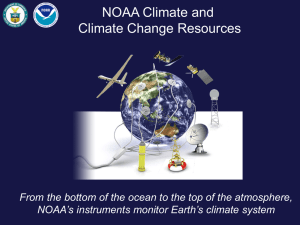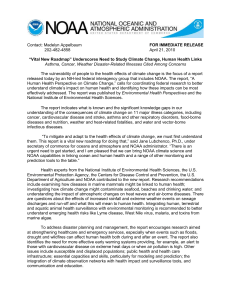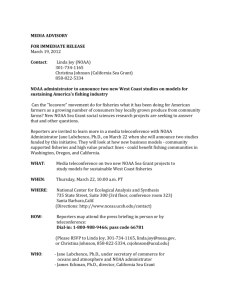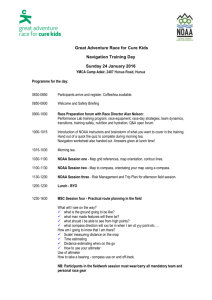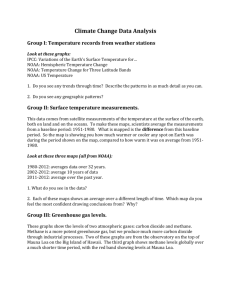Recalibration and Decomposition of SSU Measurement for Stratospheric Temperature Trend Investigation
advertisement
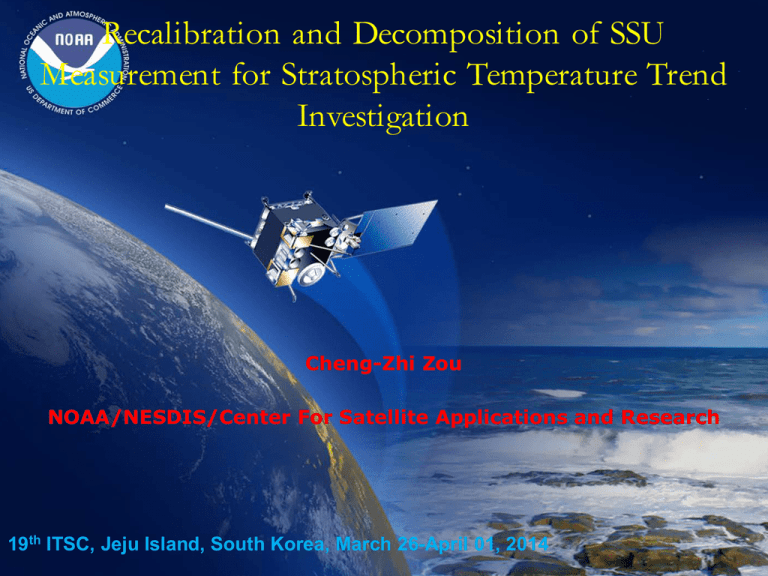
Recalibration and Decomposition of SSU Measurement for Stratospheric Temperature Trend Investigation Cheng-Zhi Zou NOAA/NESDIS/Center For Satellite Applications and Research 19th ITSC, Jeju Island, South Korea, March 26-April 01, 2014 Introduction • Stratospheric temperature trend is an important indicator of anthropogenic global warming Stratospheric cooling: Ozone depletion Increasing carbon dioxide and other greenhouse gases • Radiosonde observations difficult to reach to mid-upper stratospheres • Lidar observations are sparse • Rely on satellite observations to determine trend SSU Instrument • One of the NOAA TOVS instruments (MSU, HIRS, SSU) from 1978-2007 • Flown on seven NOAA polar orbiting satellites • Infrared radiometer use pressure modulation technique to measure atmospheric radiation from CO2 15-µm v2 band • An interference filter allows only 15-µm band to pass through • A cell of CO2 gas is placed in the instrument’s optical path with its pressure modulated in a cyclic manner • Cloud effect minimal in stratosphere • Global coverage SSU Channels • Weighting function determined by the pressure values Channel Number Cell pressure (specification) weighting function (Pre-launch specification) 1 100 (hPa) 15mb (29km) 2 35 (hPa) 5mb (37km) 3 10 (hPa) 1.5mb (45km) P(peak)~P(cell)/[CO2]1/2, Instrument Calibration 8 radiometric samples used to obtain raw counts: 6 samples also tested Averages of 4 space views and 4 warm target views to calibrate all Earth views within a calibration cycle Line Scheme (1-3, 4-7) used: sensitivity tested with different line schemes Measurements from space side Thermistor used to represent warm target temperature: PRT and sun side thermistor also tested Cold space correction implemented: NOAA-6 laboratory test data used as reference, other satellites were determined from inter-satellite biases Asymmetry correction: implementation depends on community requirement Quality control on calibration coefficients Scan and Calibration Cycle Recalibrated Radiances—With Cold Space Correction • Recalibration difference from operational calibration by a constant Recalibrated versus operational calibrated anomaly time series Differences between recalibration and NOAA operational calibration 6 The Trend Debate — channel 1 NOAA UKMO Models Plot from Thompson et al. 2012 in Nature 7 The Trend Debate – Channel 2 STAR UKMO Models Plot from Thompson et al. 2012 in Nature 8 Issues in SSU Observations Gas leaking problem in the CO2 cell atmospheric CO2 variations diurnal drift effect semi-diurnal tides Limb-effect inter-satellite biases Cell Pressure Time Series from Gas Leak • CO2 cell placed between sensor and medium to be Observed • Cell pressure determine high Of weighting function • Cell pressure decreasing due to gas leaking Plot from S.Kobayashi et al. 2009 10 Effect of Cell Pressure Decreasing CO2 cell pressure decreasing -> weighting function peaks higher -> because of increasing lapse rate, measured Tb increasing -> warm bias SSU cell pressure Weighting function Measured BT 11 Time Series of the Basic Radiances – Channel 2 Large jumps between N11 and N14 during 1995 for ch2 due to cell pressure change effect Structure errors in ch2 Ch2 VERY close to UKMO Before NOAA-14 started in 1995 Reasons for Trend Differences Between NOAA and UKMO data—Channel 2 Inter-satellite bias removal only Cell pressure time series Cell pressure adjustment 1.5 K difference for period Of 1978-2007 13 Note Tb changes in NOAA-14 corresponding to its cell pressure changes NOAA and UKMO Datasets Relationship between Ch1, Ch2, and Ch3 NOAA Version 2 SSU dataset Plot from Seidel et al. 2011 Conclusion Understood the trend differences between NOAA and UKMO data versions; Established confidence on NOAA reprocessing Certain channel features in climate model simulations were also observed in NOAA SSU dataset, which provided validation of accuracies in climate model simulations to a certain extent

![Eduardo A. Araujo-Pradere [], CIRES, University of Colorado, Solar Minimum](http://s2.studylib.net/store/data/013086460_1-158f16f4991b8d654a2183bbdcda9c6c-300x300.png)
